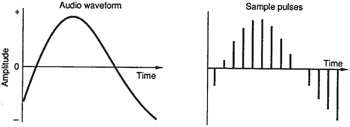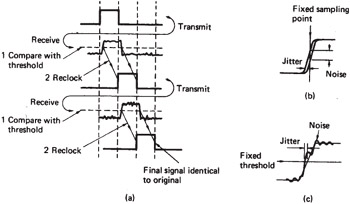1.2 Analog and Digital Communication Compared
| | ||
| | ||
| | ||
1.2 Analog and Digital Communication Compared
Before going on to examine specific digital audio and video interfaces it would be useful briefly to compare analog and digital interfaces in general, and then to look at the basic principles of digital communication.
In an analog wire link between two devices the baseband audio or video signal from a transmitter is carried directly in the form of variations in electrical voltage. Any unwanted signals induced in the wire, such as radio frequency interference (RFI) or mains hum will be indistinguishable from the wanted signal at the receiver, as will any noise or timing instability introduced between transmitter and receiver, and these are likely to affect signal quality (see Figure 1.2). Techniques such as balancing (see section 1.7.1) and the use of transmission lines (see section 1.7.3) are used in analog communication to minimize the effects of long lines and interference. Forms of modulation are used in analog links, especially in radio frequency transmission, whereby the baseband (unmodulated) signal is used to alter the characteristics of a high frequency carrier, resulting in a spectrum with a sideband structure around the carrier. Modulation may give the signal increased immunity to certain types of interference 4 , but modulated analog signals are rarely carried over wire links within a studio installation.

Figure 1.2: If noise is added to an analog signal the result is a noisy signal. In other words, the noise has become a feature of the signal which may not be separated from it.
Pulse amplitude modulation (PAM) is a means of modulating an analog signal onto a series of pulses, such that the amplitude of the pulses varies according to the instantaneous amplitude of the analog signal (see Figure 1.3) and this is the basis of pulse code modulation (PCM) whereby the amplitude of PAM pulses is quantized, resulting in a binary signal that is exceptionally immune to noise and interference since it only has two states. This process normally takes place in the analog-to-digital (A/D) convertor of an audio or video system, described in more detail in Chapter 2. PCM is the basis of all current digital audio and video interfaces, and, as shown in Figure 1.4, the effects of unwanted noise and timing instability may be rejected by reclocking the binary signal and comparing it with a fixed threshold. Provided that the receiving device is able to distinguish between the two states, one and zero, and can determine the timing slot in which each binary digit (bit) resides, the system may be shown to be able to reject any adverse effects of the link. Over long links a digital signal may be reconstructed regularly, in order to prevent it from becoming impossibly distorted and difficult to decode. Of course there will be cases in which an interfering signal will cause a sufficiently large effect on the digital signal to prevent it from being correctly reconstructed, but below the threshold at which this happens there will be no effect at all.

Figure 1.3: In pulse amplitude modulation (PAM) a regular chain of pulses is amplitude modulated by the baseband signal.

Figure 1.4: (a) A binary signal is compared with a threshold and reclocked on receipt, thus the meaning will be unchanged. (b) Jitter on a signal can appear as noise with respect to fixed timing. (c) Noise on a signal can appear as jitter when compared with a fixed threshold.
Compared with an analog baseband signal, its digital counterpart normally requires a considerably greater bandwidth, as can be seen from the diagrams above, but the advantage of a digital signal is that it can normally survive over a channel with a relatively low signal-to-noise ratio. Another advantage of digital communications is that a number of signals of different types may be carried over the same physical link without interfering with each other, since they may be time-division multiplexed (TDM), as discussed in section 1.5.5.
| | ||
| | ||
| | ||
EAN: 2147483647
Pages: 120